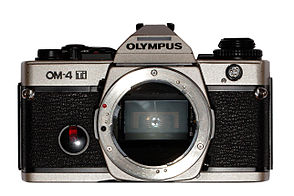Olympus OM-4 Ti
| Olympus OM-4 Ti | |

|
|
| Type: | single-lens single-lens reflex camera |
| Production period: | 1987-2002 |
| Lens connection : | Olympus OM bayonet |
| Film format : | 35 mm (small picture) |
| Recording format : | 24 × 36 mm (small picture) |
| Viewfinder : | Pentaprism finder with Fresnel lens, diopter correction −3– + 1 |
| Viewfinder field: | 97% |
| Enlargement: | 0.92 times |
| Finder Ads: | Bar display of shutter speeds from 1–1 / 2000 s in 1/3 f-stop steps; Over and under exposure warning; "+/−" display for manual measurement; Flash readiness (green LED); "Correct" flash exposure (flashing of the green LED); Display of exposure modes |
| Operating modes: | manual control through tracking measurement, automatic timing with aperture preselection, in each case with open aperture measurement. Spot measurement (2%) as single and multi-spot measurement (maximum 8 points), high-key and low-key button (in spot mode) |
| Film transport: | manual or motorized (winder / motor) |
| Exposure metering : | TTL open aperture measurement with lenses from the OM system. With tracking measurement and automatic timing, center-weighted integral (autodynamic on shutter curtain or film surface), with spot measurement using silicon measuring cells |
| Measuring range: | EV −5–19 (at 100 ISO - with the Zuiko Auto-S 50 mm f / 1.4) |
| Regulation: | Tracking principle: aperture preselection or time preselection |
| Correction : | +/- 2 f-stops in 1/3 steps |
| Closure : | electronically controlled cloth closure (horizontal) |
| Shutter speed : | 1/2000 to 240 s, B, mechanically controlled emergency time 1/60 s |
| Flash control: | TTL auto flash (OTF auto flash) automatically, up to 9 Olympus T flash units can be ignited and controlled simultaneously |
| Lightning connection : | Hot shoe (with X and linear flash contacts) and 5-pole connection socket |
| Synchronization : | 1/60 s and longer or with Olympus F280 flash unit: 1 / 60–1 / 2000s |
| Flash functions: | automatically between 1 / 60s and 1 / 2000s, manual for all times up to 1 / 2000s |
| Power supply: | 2 × SR44 / LR44, test (LED and acoustic signal) |
| Dimensions: | 136 × 84 × 50 mm |
| Weight: | 510 g |
| Additions: | Self-timer: electronically controlled, 12 seconds lead time, optical and acoustic signals |
The Olympus OM-4 Ti camera was launched in 1987. It is the revised successor to the OM-4 and was built until 2002. At first it was only available in "champagne color", later a black lacquered version was added.
The camera was designed for professional use and accordingly integrated into an extensive system of accessories. In order to meet the requirements of professional use, the top cap and base plate of the camera are made of durable titanium (as with its sister camera, the Olympus OM-3 Ti ).
The Olympus OM-4 Ti can be seen in the title sequence of the James Bond film License to Kill .
Light metering system
The OM-4 Ti was the first camera to bring the “fully synchronous” lightning metering system onto the market. With a suitable flash unit (Olympus F280), flash sync times between 1/60 s and 1/2000 s can be selected. Just like its predecessor, the Olympus OM-4 , the OM-4 Ti has an extremely sophisticated exposure metering system. In addition to manual tracking measurement, it offers automatic timing. The camera measures using center-weighted integral measurement. The measurement is carried out “autodynamically” directly on the shutter curtain or on the film surface during exposure. Thanks to the autodynamic measuring system, the camera reacts directly to changed lighting conditions and also uses this technology to achieve extremely precise flash exposures. In addition, the camera offers spot metering and multi-spot metering (up to 8 measuring points can be combined into one measurement). The measurement is carried out by a silicon photodiode and covers approx. 2% of the image field. There are also highlight and shadow buttons for very light and very dark motifs.
equipment
Camera drives
- Motor Drive : The OM system has Motor Drive 1 and Motor Drive 2. Both allow film transports up to 5 frames / second. The Motor Drive 2 also offers motorized film rewind. The following energy sources are available for the Motor Drives: NiCd pack (15 V), battery handle (18 V, for 12 batteries or rechargeable batteries of size AA), control unit with mains connection.
- Winder : The OM system includes Winder 1 and Winder 2. Winder 1 only offers single image recordings, while Winder 2 also offers series images with up to 2.5 images / second. The winders do not offer automatic film rewind.
Camera back panels
The standard rear panel can be exchanged for the following rear panels:
- OM data back wall: a back wall for imprinting the date, time and exposure data (Recorddata Back 4).
- Feature film magazines: Magazines 1 and 2 for film material for up to 250 exposures.
Focusing screens
16 interchangeable types of focusing screens, from the full focusing screen to the version with cross-section / microprism ring. The focusing screens are changed by the lens bayonet.
Flash units
In the OM system there are several flash units with different characteristics. Particularly noteworthy is the Olympus F280 fully synchronous flash unit, which offers flash sync times between 1/60 s and 1/2000 s in FP mode.
Remote release accessories
There are a number of accessories available for remote control of the OM-4 Ti, such as the remote release cable, the manual quartz remote release, etc.
literature
- Olympus OM-4 Ti instruction manual (German), no date
- Olympus OM-4 Ti-Black information brochure (German), 1/91
- Olympus OM system by Wilfried Mordmüller (German), 1989 G + G Urban Verlag GmbH, Munich, ISBN 3-925334-16-5
